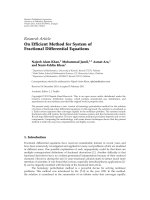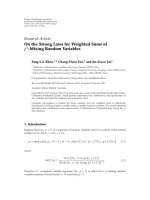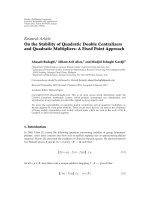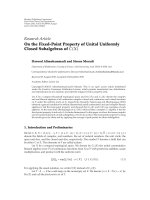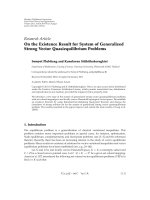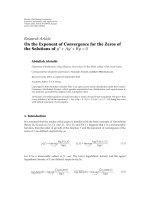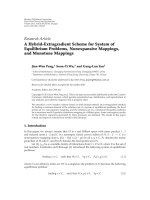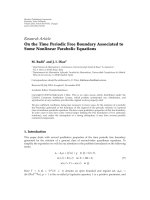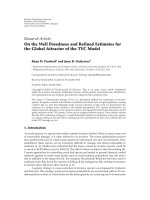Báo cáo hóa học: " Research Article On the Existence Result for System of Generalized Strong Vector Quasiequilibrium Problems Somyot Plubtieng and Kanokwan Sitthithakerngkiet" doc
Bạn đang xem bản rút gọn của tài liệu. Xem và tải ngay bản đầy đủ của tài liệu tại đây (499.18 KB, 9 trang )
Hindawi Publishing Corporation
Fixed Point Theory and Applications
Volume 2011, Article ID 475121, 9 pages
doi:10.1155/2011/475121
Research Article
On the Existence Result for System of Generalized
Strong Vector Quasiequilibrium Problems
Somyot Plubtieng and Kanokwan Sitthithakerngkiet
Department of Mathematics, Faculty of Science, Naresuan University, Phitsanulok 65000, Thailand
Correspondence should be addressed to Somyot Plubtieng,
Received 3 December 2010; Accepted 12 January 2011
Academic Editor: Qamrul Hasan Ansari
Copyright q 2011 S. Plubtieng and K. Sitthithakerngkiet. This is an open access article distributed
under the Creative Commons Attribution License, which permits unrestricted use, distribution,
and reproduction in any medium, provided the original work is properly cited.
We introduce a new type of the system of generalized strong vector quasiequilibrium problems
with set-valued mappings in real locally convex Hausdorff topological vector spaces. We establish
an existence theorem by using Kakutani-Fan-Glicksberg fixed-point theorem and discuss the
closedness of strong solution set for the system of generalized strong vector quasiequilibrium
problem. The results presented in the paper improve and extend the main results of Long et al.
2008.
1. Introduction
The equilibrium problem is a generalization of classical variational inequalities. This
problem contains many important problems as special cases, for instance, optimization,
Nash equilibrium, complementarity, and fixed-point problems see 1–3 and the references
therein. Recently, there has been an increasing interest in the study of vector equilibrium
problems. Many results on existence of solutions for vector variational inequalities and vector
equilibrium problems have been established see, e.g., 4–16.
Let X and Z be real locally convex Hausdorff space, K ⊂ X anonemptysubsetand
C ⊂ Z be a closed convex pointed cone. Let F : K × K → 2
Z
be a given set-valued mapping.
Ansari et al. 17 introduced the following set-valued vector equilibrium problems VEPs to
find x ∈ K such that
F
x, y
/
⊆−int C ∀y ∈ K, 1.1
2 Fixed Point Theory and Applications
or to find x ∈ K such that
F
x, y
⊂ C ∀y ∈ K. 1.2
If int C is nonempty, and x satisfies 1.1,thenwecallx aweakefficient solution for
VEP,andifx satisfies 1.2,thenwecallx a strong solution for VEP. Moreover, they also
proved an existence theorem for a strong vector equilibrium problem 1.2see 17.
In 2000, Ansari et al. 5 introduced the system of vector equilibrium problems
SVEPs, that is, a family of equilibrium problems for vector-valued bifunctions defined
on a product set, with applications in vector optimization problems and Nash equilibrium
problem 11 for vector-valued functions. The SVEP contains system of equilibrium
problems, systems of vector variational inequalities, system of vector variational-like
inequalities, system of optimization problems and the Nash equilibrium problem for vector-
valued functions as special cases. But, by using SVEP, we cannot establish the existence
of a solution to the Debreu type equilibrium problem 7 for vector-valued functions
which extends the classical concept of Nash equilibrium problem for a noncooperative
game. Moreover, Ansari et al. 18 introduced the following concept of system of vector
quasiequilibrium problems.
Let I be any index set and for each i ∈ I
,letX
i
be a topological vector space. Consider
a family of nonempty convex subsets {K
i
}
i∈I
with K
i
⊂ X
i
.WedenotebyK
i∈I
K
i
and
X
i∈I
X
i
.Foreachi ∈ I,letY
i
be a topological vector space and let C
i
: K → 2
Y
i
and
S
i
: K → 2
K
i
be multivalued mappings and F
i
: K × K → Y
i
be a bifunction. The system of
vector quasiequilibrium problems SVQEPs,thatis,tofindx ∈ K such that for each i ∈ I,
x
i
∈ S
i
x
: F
i
x, y
i
/
∈−int C
i
x
∀y
i
∈ S
i
x
. 1.3
If S
i
xK
i
for all x ∈ K,thenSVQEP reduces to SVEPsee 5 and if the index set
I is singleton, then SVQEP becomes the vector quasiequilibrium problem. Many authors
studied the existence of solutions for systems of vector quasiequilibrium problems, see, for
example, 19–23 and references therein.
On the other hand, it is well known that a strong solution of vector equilibrium
problem is an ideal solution, It is better than other solutions such as efficient solution, weak
efficient solution, proper efficient solution and supper efficient solution see 13. Thus, it is
important to study the existence of strong solution and properties of the strong solution set.
In general, the ideal solutions do not exist.
Very recently, the generalized strong vector quasiequilibrium problem GSVQEPs is
introduced by Long et al. 16.LetX, Y ,andZ are real locally convex Hausdorff topological
vector spaces, K ⊂ X and D ⊂ Y are nonempty compact convex subsets, and C ⊂ Z is a
nonempty closed convex cone. Let S : K → 2
K
, T : K → 2
D
,andF : K × D × K → 2
Z
are
three set-valued mappings. They considered the GSVQEP: finding x ∈ K, y ∈ Tx such that
x ∈ Sx and
F
x, y, z
⊂ C, ∀z ∈ S
x
. 1.4
Moreover, they gave an existence theorem for a generalized strong vector quasiequilibrium
problem without assuming that the dual of the ordering cone has a weak
∗
compact base.
Fixed Point Theory and Applications 3
Motivated and inspired by research works mentioned above, in this paper, we
introduce a different kind of systems of generalized strong vector quasiequilibrium problem
without assuming that the dual of the ordering cone has a weak
∗
compact base. Let X, Y,
and Z are real locally convex Hausdorff topological vector spaces, K ⊂ X and D ⊂ Y are
nonempty compact convex subsets, and C ⊂ Z is a nonempty closed convex cone. We also
suppose that S
1
,S
2
: K → 2
K
, T
1
,T
2
: K → 2
D
and F
1
,F
2
: K × D × K → 2
Z
are set-valued
mappings. We consider the following system of generalized strong vector quasiequilibrium
problem SGSVQEPs:finding
x, u ∈ K × K and v ∈ T
1
x, y ∈ T
2
u such that x ∈ S
1
x,
u ∈ S
2
u satisfying
F
1
x, y,z
⊂ C ∀z ∈ S
1
x
,
F
2
u, v, z
⊂ C ∀z ∈ S
2
u
.
1.5
We call this
x, u a strong solution for the SGSVQEP.
At a quick glance, our required solution seems to be similar to such a thing of Ansari
et al. 5, 18,inthecaseofI {1, 2} and K
1
K
2
. In fact, however, the main different point
comes from the independent choice of coordinate. In this paper, we establish an existence
theorem of strong solution set for the system of generalized strong vector quasiequilibrium
problem by using Kakutani-Fan-Glicksberg fixed-point theorem and discuss the closedness
of the solution set. Moreover, we apply our result to obtain the result of Long et al. 16.
2. Preliminaries
Throughout this paper,we suppose that X, Y,andZ are real locally convex Hausdorff
topological vector spaces, K ⊂ X and D ⊂ Y are nonempty compact convex subsets,
and C ⊂ Z is a nonempty closed convex cone. We also suppose that S
1
,S
2
: K → 2
K
,
T
1
,T
2
: K → 2
D
,andF
1
,F
2
: K × D × K → 2
Z
are set-valued mappings.
Definition 2.1. Let X and Y be two topological vector spaces and K anonemptysubsetofX
and let F : K → 2
Y
be a set-valued mapping.
i F is called upper C-continuous at x
0
∈ K if, for any neighbourhood U of the origin
in Y , there is a neighbourhood V of x
0
such that, for all x ∈ V ,
F
x
⊂ F
x
0
U C. 2.1
ii F is called lower C-continuous at x
0
∈ K if , for any neighbourhood U of the origin
in Y , there is a neighbourhood V of x
0
such that, for all x ∈ V ,
F
x
0
⊂ F
x
U − C. 2.2
Definition 2 .2. Let X and Y be two topological vector spaces and K a nonempty convex subset
of X. A set-valued mapping F : K → 2
Y
is said to be properly C-quasiconvex if, for any
x, y ∈ K and t ∈ 0 , 1,wehave
either F
x
⊂ F
tx
1 − t
y
C or F
y
⊂ F
tx
1 − t
y
C. 2.3
4 Fixed Point Theory and Applications
Definition 2.3. Let X and Y be two topological vector spaces, and T : X → 2
Y
be a set-valued
mapping.
i T is said to be upper semicontinuous at x ∈ X if, for any open set V containing
Tx, there exists an open set U containing x such that, for all t ∈ U, Tt ⊂ V ; T is
said to be upper semicontinuous on X if it is upper semicontinuous at all x ∈ X.
ii T is said to be lower semicontinuous at x ∈ X if, for any open set V with Tx∩V
/
∅,
there exists an open set U containing x such that, for all t ∈ U, Tt ∩ V
/
∅; T is said
to be lower semicontinuous on X if it is lower semicontinuous at all x ∈ X.
iii T is said to be continuous on X if, it is at the same time upper semicontinuous and
lower semicontinuous on X.
iv T is said to be closed if the graph, GraphT,ofT,thatis,GraphT{x, y : x ∈ X
and y ∈ Tx},isaclosedsetinX × Y .
Lemma 2.4 see 12. Let K be a nonempty compact subset of locally convex Hausdorff vector
topology space E.IfS : K → 2
K
is upper semicontinuous and for any x ∈ K, Sx is nonempty,
convex and closed, then there exists an x
∗
∈ K such that x
∗
∈ Sx
∗
.
Lemma 2.5 see 24. Let X and Y be two Hausdorff topological vector spaces and T : X → 2
Y
be
a set-valued mapping. Then, the following properties hold:
i if T is closed and
TX is compact, then T is upper semicontinuous, where TX
x∈X
Tx and E denotes the closure of the set E,
ii if T is upper semicontinuous and for any x ∈ X, Tx is closed, then T is closed,
iii T is lower semicontinuous at x ∈ X if and only if for any y ∈ Tx and any net {x
α
},x
α
→
x, there exists a net {y
α
} such that y
α
∈ Tx
α
and y
α
→ y.
3. Main Results
In this section, we apply Kakutani-Fan-Glicksberg fixed-point theorem to prove an existence
theorem of strong solutions for the system of generalized strong vector quasiequilibrium
problem. Moreover, we also prove the closedness of strong solution set for the system of
generalized strong vector quasiequilibrium problem.
Theorem 3.1. For each i {1, 2},letS
i
: K → 2
K
be continuous set-valued mappings such that
for any x ∈ K, S
i
x are nonempty closed convex subsets of K.LetT
i
: K → 2
D
be upper semi
continuous set-valued mappings such that for any x ∈ K, T
i
x are nonempty closed c onvex subsets
of D and F
i
: K × D × K → 2
Z
be set-valued mappings satisfy the following conditions:
i for all x, y ∈ K × D, F
i
x, y, S
i
x ⊂ C,
ii for all y, z ∈ D × K, F
i
·,y,z are properly C-quasiconvex,
iii F
i
·, ·, · are upper C-continuous,
iv for all y ∈ D, F
i
·,y,· are lower −C-continuous.
Then, SGSVQEP has a solution. Moreover, the set of all strong solutions is closed.
Fixed Point Theory and Applications 5
Proof. For any x, y ∈ K × D, define set-valued mappings A, B : K × D → 2
K
by
A
x, y
a ∈ S
1
x
: F
1
a, y, z
⊂ C, ∀z ∈ S
1
x
,
B
x, y
b ∈ S
2
x
: F
2
b, y, z
⊂ C, ∀z ∈ S
2
x
.
3.1
Step 1. Show that Ax, y and Bx, y are nonempty.
For any x ∈ K,wenotethatS
1
x and S
2
x are nonempty. Thus, for any x, y ∈ K×D,
we have Ax, y and Bx, y are nonempty.
Step 2. Show that Ax, y and Bx, y are convex subsets of K.
Let a
1
,a
2
∈ Ax, y and λ ∈ 0, 1.Puta λa
1
1 − λa
2
.Sincea
1
,a
2
∈ S
1
x and
S
1
x is convex set, we have a ∈ S
1
x.Byii, F
1
·,y,z is properly C-quasiconvex. Without
loss of generality, we can assume that
F
1
a
1
,y,z
⊂ F
1
λa
1
1 − λ
a
2
,y,z
C. 3.2
We claim that a ∈ Ax, y.Infact,ifa
/
∈ Ax, y, then there exists z
∗
∈ S
1
x such that
F
1
a, y, z
∗
/
⊆C. 3.3
It follows that
F
1
a
1
,y,z
∗
⊂ F
1
λa
1
1 − λ
a
2
,y,z
∗
C
/
⊆C C ⊂ C, 3.4
which contradicts to a
1
∈ Ax, y. Therefore a ∈ Ax, y and hence Ax, y is a convex subset
of K. Similarly, we have Bx, y is convex subset of K.
Step 3. Show that Ax, y and Bx, y are closed subsets of K.
Let {a
α
} be a sequence in Ax, y such that a
α
→ a
∗
. Thus, we have a
α
∈ S
1
x.Since
S
1
x is a closed subset of K, it follows that a
∗
∈ S
1
x. By the lower semicontinuity of S
1
and
Lemma 2.5iii,foranyz
∗
∈ S
1
x and any net {x
α
}→x, there exists a net {z
α
} such that
z
α
∈ S
1
x
α
and z
α
→ z
∗
. This implies that
F
1
a
α
,y,z
α
⊂ C. 3.5
Since F
1
·,y,· is lower −C-continuous, for any neighbourhood U of the origin in Z,there
is a subnet {a
β
,z
β
} of {a
α
,z
α
} such that
F
1
a
∗
,y,z
∗
⊂ F
1
a
β
,y,z
β
U C. 3.6
From 3.5 and 3.6,wehave
F
1
a
∗
,y,z
∗
⊂ U C. 3.7
6 Fixed Point Theory and Applications
We claim that F
1
a
∗
,y,z
∗
⊂ C. Assume that there exists p ∈ F
1
a
∗
,y,z
∗
and p
/
∈ C.Thus,we
note that 0
/
∈ C−p and C−p is closed. Hence Z\C−p is open and 0 ∈ Z\C−p.SinceZ is a
locally convex space, there exists a neighbourhood U
0
of the origin such that U
0
⊂ Z \ C −p
is convex and U
0
−U
0
. This implies that 0
/
∈ U
0
C − p,thatis,p
/
∈ U
0
C,whichisa
contradiction. Therefore F
1
a
∗
,y,z
∗
⊂ C. This mean that a
∗
∈ Ax, y and so Ax, y is a
closed subset of K. Similarly, we have Bx, y is a closed subset of K.
Step 4. Show that Ax, y and Bx, y are upper semicontinuous.
Let {x
α
,y
α
: α ∈ I}⊂K × D be given such that x
α
,y
α
→ x, y ∈ K × D,and
let a
α
∈ Ax
α
,y
α
such that a
α
→ a.Sincea
α
∈ S
1
x
α
and S
1
is upper semicontinuous,
it follows by Lemma 2.5ii that a ∈ S
1
x.Wenowclaimthata ∈ Ax, y. Assume that
a
/
∈ Ax, y. Then, there exists z
∗
∈ S
1
x such that
F
1
a, y, z
∗
/
⊆C, 3.8
which implies that there is a neighbourhood U
0
of the origin in Z such that
F
1
a, y, z
∗
U
0
/
⊆C. 3.9
Since F
1
is upper C-continuous, for any neighbour hood U of the origin in Z,thereexistsa
neighbourhood U
1
of a, y, z
∗
such that
F
1
a, y, z
⊂ F
1
a, y, z
∗
U C, ∀
a, y, z
∈ U
1
. 3.10
Without loss of generality, we can assume that U
0
U.Thisimpliesthat
F
1
a, y, z
⊂ F
1
a, y, z
∗
U
0
C
/
⊆C C ⊂ C, ∀
a, y, z
∈ U
1
. 3.11
Thus there is α
0
∈ I such that
F
1
a
α
,y
α
,z
α
/
⊆C, ∀α ≥ α
0
, 3.12
which contradicts to a
α
∈ Ax
α
,y
α
.Hencea ∈ Ax, y and, therefore, A is a closed mapping.
Since K is a compact set and Ax, y is a closed subset of K,wenotethatAx, y is compact.
Then,
Ax, y is also compact. Hence, by Lemma 2.5i, Ax, y is an upper semicontinuous
mapping. Similarly, we note that Bx, y is an upper semicontinuous mapping.
Step 5. Show that SGSVQEP has a solution.
Define the set-valued mapping H
a
: K × D → 2
K×D
and G
b
: K × D → 2
K×D
by
H
a
x, y
A
x, y
,T
1
a
∀
x, y
∈ K × D,
G
b
x, y
B
x, y
,T
2
b
∀
x, y
∈ K × D.
3.13
Then, H
a
and G
b
are upper semicontinuous and, for all x, y ∈ K × D, H
a
x, y,andG
b
x, y
are nonempty closed convex subsets of K × D.
Fixed Point Theory and Applications 7
Define the set-valued mapping M : K × D × K × D → 2
K×D×K×D
by
M
x, y
,
u, v
H
u
x, y
,G
x
u, v
, ∀
x, y
,
u, v
∈
K × D
×
K × D
. 3.14
Then, M is also upper semicontinuous and, for all x, y, u, v ∈ K × D × K × D,
Mx, y, u, v is a nonempty closed convex subset of K×D×K×D.ByLemma 2.4,there
exists a point
x, y, u, v ∈ K × D × K × D such that x, y, u, v ∈ Mx, y, u, v,
that is
x, y
∈ H
u
x, y
,
u, v
∈ G
x
u, v
. 3.15
This implies that
x ∈ Ax, y, y ∈ T
1
u, u ∈ Bu, v,andv ∈ T
2
x. T hen, there exists
x, u ∈ K × K and y ∈ T
1
u, v ∈ T
2
x such that x ∈ S
1
x, u ∈ S
2
u,
F
1
x, y, z
⊂ C, ∀z ∈ S
1
x
,F
2
u, v, z
⊂ C, ∀z ∈ S
2
u
. 3.16
Hence SGSVQEP has a solution.
Step 6. Show that the set of solutions of SGSVQEP is closed.
Let {x
α
,u
α
: α ∈ I} be a net in the set of solutions of SGSVQEP such that x
α
,u
α
→
x
∗
,u
∗
. By definition of the set of solutions of SGSVQEP, we note that there exist v
α
∈ T
1
x
α
,
y
α
∈ T
2
u
α
, x
α
∈ S
1
x
α
,andu
α
∈ S
2
u
α
satisfying
F
1
x
α
,y
α
,z
⊂ C, ∀z ∈ S
1
x
α
,F
2
u
α
,v
α
,z
⊂ C, ∀z ∈ S
2
u
α
. 3.17
Since S
1
and S
2
are continuous closed valued mappings, we obtain x
∗
∈ S
1
x
∗
and u
∗
∈
S
2
u
∗
.Letv
α
→ v
∗
and y
α
→ y
∗
.SinceT
1
and T
2
are upper semicontinuous closed valued
mappings, it follows by Lemma 2.5ii that T
1
and T
2
areclosed.Thus,wenotethatv
∗
∈ T
1
x
∗
and y
∗
∈ T
2
u
∗
.SinceF
1
·,y
∗
, · and F
2
·,v
∗
, · are lower −C-continuous, we have
F
1
x
∗
,y
∗
,z
⊂ C, ∀z ∈ S
1
x
∗
,F
2
u
∗
,v
∗
,z
⊂ C, ∀z ∈ S
2
u
∗
. 3.18
This means that x
∗
,u
∗
belongs to the set of solutions of SGSVQEP. Hence the set of solutions
of SGSVQEP is closed set. This completes the proof.
If we take S S
1
S
2
, F F
1
F
2
,andT T
1
T
2
. Then, from Theorem 3.1,we
derive the following result.
Corollary 3.2. Let S : K → 2
K
be a continuous set-valued mapping such that for any x ∈ K, Sx
is nonempty closed convex subset of K.LetT : K → 2
D
be an upper semicontinuous set-valued
mapping such that for a ny x ∈ K, Tx is a nonempty closed convex subset of D and F : K ×D×K →
2
Z
be set-valued mapping satisfy the following conditions:
i for all x, y ∈ K × D, Fx, y, Sx ⊂ C,
ii for all y, z ∈ D × K, F·,y,z is properly C-quasiconvex,
8 Fixed Point Theory and Applications
iii F·, ·, · is an upper C-continuous,
iv for all y ∈ D, F·,y,· is a lower −C-continuous,
v if x ∈ Sx and u ∈ Su then TxTu.
Then, GSVQEP has a solution. Moreover, the set of all solution of GSVQEP is closed.
Now we give an example to explain that Theorem 3.1 is applicable.
Example 3.3. Let X Y Z R, C 0, ∞,andK D 0, 1.Foreachx ∈ K,let
S
1
xx, 1, S
2
x0,x and T
1
x1 − x, 1, T
2
xx, 1. We consider the set-valued
mappings F
1
,F
2
: K × D × K → 2
Z
defined by
F
1
x, y, z
x − y z, ∞
∀
x, y, z
∈ K × D × K,
F
2
x, y, z
y − x z, ∞
∀
x, y, z
∈ K × D × K.
3.19
Then, it is easy to check that all of condition i–iv in Theorem 3.1 are satisfied. Hence, by
Theorem 3.1,SGSVQEPhasasolution.LetE be the set of all strong solutions for SGSVQEP.
Then, we note that
E
x, u, y, v
∈ K × K × T
2
u
× T
1
x
: x ∈ S
1
x
, u ∈ S
2
u
such that
F
1
x, y,z
⊂ C, ∀z ∈ S
1
x
,F
2
u, v, z
⊂ C, ∀z ∈ S
2
u
1/3≤a≤0.5
{
a
}
×
1 − a, 2a
×
0, 1 − a
×
1 − a, 1
.
3.20
Acknowledgments
The authors would like to thank the referees for the insightful comments and suggestions. S.
Plubtieng the Thailand Research Fund for financial support under Grants no. BRG5280016.
Moreover, K. Sitthithakerngkiet would like to thanks the Office of the Higher Education
Commission, Thailand for supporting by grant fund under Grant no. CHE-Ph.D-SW-
RG/41/2550, Thailand.
References
1 M. Bianchi and S. Schaible, “Generalized monotone bifunctions and equilibrium problems,” Journal
of Optimization Theory and Applications, vol. 90, no. 1, pp. 31–43, 1996.
2 E. Blum and W. Oettli, “From optimization and variational inequalities to equilibrium problems,” The
Mathematics Student, vol. 63, no. 1–4, pp. 123–145, 1994.
3 W. Oettli and D. Schl
¨
ager, “Existence of equilibria for monotone multivalued mappings,” Mathematical
Methods of Operations Research, vol. 48, no. 2, pp. 219–228, 1998.
4 Q.H.Ansari,W.Oettli,andD.Schl
¨
ager, “A generalization of vectorial equilibria,” Mathematical
Methods of Operations Research, vol. 46, no. 2, pp. 147–152, 1997.
5 Q. H. Ansari, S. Schaible, and J. C. Yao, “System of vector equilibrium problems and its applications,”
Journal of Optimization Theory a nd Applications, vol. 107, no. 3, pp. 547–557, 2000.
6 M. Bianchi, N. Hadjisavvas, and S. Schaible, “Vector equilibrium problems with generalized
monotone bifunctions,” Journal of Optimization Theory and Applications, vol. 92, no. 3, pp. 527–542,
1997.
Fixed Point Theory and Applications 9
7 G. Debreu, “A social equilibrium existence theorem,” Proceedings of the National Academy of Sciences of
the United States of America, vol. 38, pp. 886–893, 1952.
8 J Y. Fu, “Generalized vector quasiequilibrium problems,” Mathematical Methods of Operations Research,
vol. 52, no. 1, pp. 57–64, 2000.
9 F. Giannessi, Vector Variational Inequilities and Vector Equilibria, Mathematical Theories, vol. 38, Kluwer
Academic Publishers, Dordrecht, The Netherlands, 2000.
10 X. Gong, “Strong vector equilibrium problems,” Journal of G lobal Optimization, vol. 36, no. 3, pp. 339–
349, 2006.
11 X. H. Gong, “Efficiency and Henig efficiency for vector equilibrium problems,” Journal of Optimization
Theory and Applications, vol. 108, no. 1, pp. 139–154, 2001.
12 R. B. Holmes, Geometric Functional Analysis and Its Application, Graduate Texts in Mathematics, no. 2,
Springer, New York, NY, USA, 1975.
13 S. H. Hou, X. H. Gong, and X. M. Yang, “Existence and stability of solutions for generalized Ky Fan
inequality problems with trifunctions,” Journal of Optimization Theory and Applications, vol. 146, no. 2,
pp. 387–398, 2010.
14 N. J. Huang, J. Li, and H. B. Thompson, “Stability for parametric implicit vector equilibrium
problems,” Mathematical and Computer Modelling, vol. 43, no. 11-12, pp. 1267–1274, 2006.
15 S. J. Li, K. L. Teo, and X. Q. Yang, “Generalized vector quasiequilibrium problems,” Mathematical
Methods of Operations Research, vol. 61, no. 3, pp. 385–397, 2005.
16 X. Long, N. Huang, and K. Teo, “Existence and stability of solutions for generalized strong vector
quasiequilibrium problem,” Mathematical and Computer Modelling, vol. 47, no. 3-4, pp. 445–451, 2008.
17 Q. H. Ansari, W. Oettli, and D. Schiager, “A generalization of vectorial equilibria,” in Proceedings of
the 2nd International Symposium on Operations Research and Its Applications (ISORA ’96), vol. 1114, pp.
181–185, World Publishing, Guilin, China, December1996.
18 Q. H. Ansari, W. K. Chan, and X. Q. Yang, “The system of vector quasiequilibrium problems with
applications,” Journal of Global Optimization, vol. 29, no. 1, pp. 45–57, 2004.
19 Q. H. Ansari, “Existence of solutions of systems of generalized implicit vector quasiequilibrium
problems,” Journal of Mathematical Analysis and Applications
, vol. 341, no. 2, pp. 1271–1283, 2008.
20 Q. H. Ansari and Z. Khan, “System of generalized vector quasiequilibrium problems with
applications,” in Mathematical Analysis and Applications, S. Nanda and G. P. Rajasekhar, Eds., vol. 7,
pp. 1–13, Nar osa, New Delhi, India, 2004.
21 Q. H. Ansari, L. J. Lin, and L. B. Su, “Systems of simultaneous generalized vector quasiequilibrium
problems and their applications,” Journal of Optimization Theory and Applications, vol. 127, no. 1, pp.
27–44, 2005.
22 Q. H. Ansari, S. Schaible, and J C. Yao, “The system of generalized vector equilibrium problems with
applications,” Journal of Global Optimization, vol. 22, no. 1–4, pp. 3–16, 2002.
23 L J. Lin, “System of generalized vector quasiequilibrium problems with applications to fixed point
theorems for a family of nonexpansive multivalued mappings,” Journal of Global Optimization, vol. 34,
no. 1, pp. 15–32, 2006.
24 J P. Aubin and I. Ekeland, Applied Nonlinear Analysis, Pure and Applied Mathematics, John Wiley &
Sons, New York, NY, USA, 1984.
